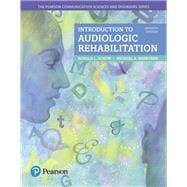A renowned team of experts presents a thorough introduction to aural rehabilitation across the lifespan.
Introduction to Audiologic Rehabilitation provides a cohesive introduction to the basics of audiologic rehabilitation in an easy-to-read style that resonates with undergraduate students. Highly regarded as experts in the field, the authors introduce the fundamentals, present the important methods and procedures, and include two case study chapters that address the rehabilitation needs of both children and adults. They examine the changing state of audiology through coverage of important contemporary issues such as professional documents, evidence-based practice, multicultural issues, and advances in computer and web-based rehabilitation activities. Based on a proven model framed within the concepts of the World Health Organization, this book helps students prepare to provide high-quality, state-of-the-art services to clients of any age.
The Seventh Edition features an enhanced focus on cochlear implants in Chapter 3 and revised discussions of vestibular and tinnitus treatments. New chapter learning outcomes, supplementary learning activities, references, and recommended websites keep readers focused and engaged with the material.










